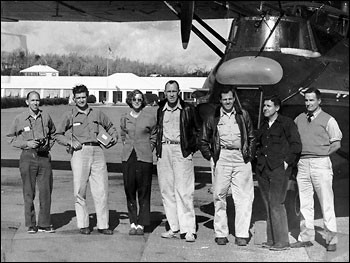

“Hot Tower” HypothesisUpon earning her Ph.D., Simpson had a husband, one child, and no job. Frustrated after being repeatedly turned down because of her gender, she eventually landed a position at the Illinois Institute of Technology, where she eventually became an Assistant Professor of Physics. During the summers, Simpson (now Joanne Malkus) traveled to Woods Hole Oceanographic Institute with her family (now two boys) to work on an exciting project involving tropical clouds. Simpson moved to the Woods Hole Oceanographic Institution after deciding to leave Chicago for a better place to raise her young children. There she began to develop a model of cumulus clouds and to take the first steps in demonstrating how important these clouds were in driving tropical circulations. 
Simpson, in collaboration with Herbert Riehl, proposed the “Hot Tower” hypothesis of tropical convection in 1958. Predictions of the hypothesis were verified by field experiments 20 years later. Hot towers are clouds that carry undiluted warm, moist air from the ocean surface 15,000 meters (50,000 feet) into the air. This tower was photographed from a NOAA aircraft in 1970. (Photograph courtesy NOAA Photo Library) No one at that time really understood the workings of the Hadley circulation (the atmospheric movements that transport heat and moisture from the tropics toward higher latitudes). Simpson felt the answers lay in the very tall clouds in equatorial regions. But to get answers, she needed many more observations. At Simpson’s request, the Office of Naval Research provided the Woods Hole team with an old PBY-6A airplane, which they outfitted with instruments that measured wind motions, humidity, liquid water, air pressure, temperature, and more. “Getting the first instrumented airplane,” she says, “and arguing that trade cumulus clouds were important and that we ought to go make measurements of them was the biggest contribution I made at Woods Hole.” Initially, Woods Hole said that women were not allowed on their field trips. The Navy Officer who had arranged the aircraft to go to Woods Hole told the Director, “No Joanne, no airplane.” 
The Navy provided a PBY flying boat to the Woods Hole Oceanographic Institute so Joanne Simpson could study tropical clouds. In this photograph she stands with her crew in front of the aircraft. (Photograph courtesy Joanne Simpson and the Schlesinger Library) The results of that first field trip established her reputation as a good scientist. In the late 1950s, Simpson and her former Ph.D. advisor, Riehl, turned meteorology on its ear when they showed that heat generated by the condensation of water within tall, anvil-shaped, cumulonimbus clouds called “hot towers” provides the energy needed to keep the Hadley circulation and the trade winds running. Some people doubted this “hot tower hypothesis.” They claimed that the energy released by the clouds would be diluted by outside air before it ever reached the cloud tops. Simpson and Riehl demonstrated that these “protected cores” of energy transport are not only possible, but that they occur all the time in equatorial regions. next: Warm Core Mystery
|
| ||